

HS2 Ltd admit to ignoring public consultation responses from those opposed to HS2. Published 24th July 2012.
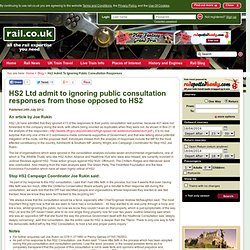
Top gear dragons den « Penpal. Drive straight onto train. A Tiny, Fold-up Electric Car Will Hit Streets This Year. The Hiriko Fold, an electric car that originally began as a research project at MIT, is tiny—smaller than Daimler's smart car.
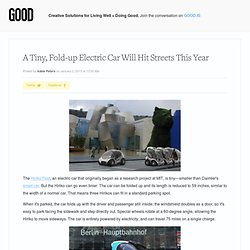
But the Hiriko can go even tinier: The car can be folded up and its length is reduced to 59 inches, similar to the width of a normal car. That means three Hirikos can fit in a standard parking spot. When it's parked, the car folds up with the driver and passenger still inside; the windshield doubles as a door, so it's easy to park facing the sidewalk and step directly out. Special wheels rotate at a 60-degree angle, allowing the Hiriko to move sideways. The car is entirely powered by electricity, and can travel 75 miles on a single charge. A firm prediction... HS2 will never happen. "The third factor is the politics.

The Tories were willing to swallow unhappiness amongst shire Tories if the project won support in target northern seats. Again both sides of this equation have changed. The party leadership had calculated that neither Labour nor the LibDems as supporters of HS2 would seek to capitalise on southern discontent. Catching the train bug. Shunting HS2 rail project into sidings not an option - Comment / Business. A fair amount of knickers were in a twist this week after Chancellor George Osborne’s announcement of an extension to the UK’s proposed high-speed rail project.

The £32 billion scheme will now be extended north from Birmingham along two branch lines linking Nottingham, Sheffield, Leeds and Manchester to the new network. The Government estimates HS2 will slash journey times between Manchester and London by an hour, to 68 minutes. Connection times between cities across Middle England will also be dramatically reduced as a result. Public attitudes towards train services - Publications. Summary This publication summarises adults’ experiences of, and attitudes towards, rail travel in the United Kingdom using questions asked on the Office for National Statistics Opinions omnibus survey in April 2012.
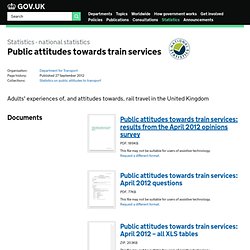
It covers: short distance rail journeys of less than 50 miles and long distance rail journeys of more than 50 miles the accessibility of railway stations the frequency and purpose of rail journeys how users and non-users rate and perceive rail services whether experiences have met expectations which features users most value why non-users and infrequent users do not use services more often and what improvements would encourage them to use trains more often opinions on the number and range of train tickets available and their ratings of a number of ticket features Background and technical information ONS Opinions survey. 310mph 'floating' trains unveiled in Japan. New tech to cut time between trains to 2 minutes. The Western Railway is exploring a new technology that could increase the frequency of trains on the suburban section, reducing the gap between two trains to just two minutes from the existing three.

The Mumbai Rail Vikas Corporation (MRVC) has sent a proposal to the railway board, seeking approval of a detailed engineering study of the new communication-based train control technology. This is an advanced control system which not only enhances the safety of trains, but also allows them to run at higher speeds. At present, about 17-18 trains run on one line in an hour. Once the new technology is adopted, about 24 to 25 trains will run on one line in an hour. This means passenger load at any hour will be shared by more trains, leading to less crowds. In the past, railway operators have seen signal equipment solely as a means to ensure safety. www.ltg-ag.de/fileadmin/_temp_/downloads/dokumentationen/raumlufttechnik/Branchen-und_Systemloesungen/LTG_Railway_Technology.pdf.
www.hitachi.com/rev/1999/revjun99/r3_107.pdf. Australian first: new technology to improve railway crossing safety. Friday, 01 April 2011 In an Australian first, a trial of an innovative level crossing warning system to prevent collisions between trains and road vehicles has been conducted this week in Yendon, Minister for Public Transport Terry Mulder said today.
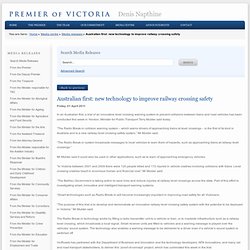
“The Radio Break-in collision warning system – which warns drivers of approaching trains at level crossings – is the first of its kind in Australia and is a new railway level crossing safety system,” Mr Mulder said. “The Radio Break-in system broadcasts messages to local vehicles to warn them of hazards, such as approaching trains at railway level crossings.” Mr Mulder said it could also be used in other applications, such as to warn of approaching emergency vehicles. “In Victoria between 2001 and 2009 there were 120 people killed and 172 injured in vehicle crashes involving collisions with trains. “The Baillieu Government is taking action to save lives and reduce injuries at railway level crossings across the state. www.tc.gc.ca/media/documents/railsafety/technologies.pdf. New Technology Harvests Electricity From Railroad Train Track Vibrations. Train photo from Shutterstock Anyone who has stood next to a train pulling into a station can attest to the immense power it produces as it rattles along the rails.

Scientists at Stony Brook University recently won a national award their mechanical motion rectifier (MMR)-based Railroad Energy Harvester – an invention that harvests electricity from the vibrations produced by railroad trains. The invention has the potential to save millions in railroad energy costs while reducing carbon emissions. The U.S. has the longest network of railroad tracks in the world – it spans 140,700 miles in total. Many of these railways lie in remote areas where it is at times difficult to supply power to signal lights, cross gates, and railroad switches. The team’s work won them a national award from the Energy Harvesting and Storage USA 2012 conference held earlier this month. . + Stony Brook University Via ScienceDaily. 308na4rss. Trends Feature Articles, Page 1. Our high speed rail future. 21 July 2011Last updated at 09:07.

The Future of Train Transportation" The success of the U.S. freight railroad system has shown that moving goods by rail can be economical, efficient and profitable.
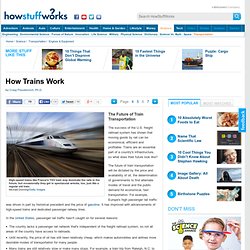
Trains are an essential part of a country's infrastructure, so what does their future look like? The future of train transportation will be dictated by the price and availability of oil, the determination of governments to find alternate modes of travel and the public demand for economical, fast transportation. For example, Europe's high passenger rail traffic was driven in part by historical precedent and the price of gasoline. It has improved with advancements of high-speed trains and dedicated passenger railway lines. In the United States, passenger rail traffic hasn't caught on for several reasons: However, as oil prices increase, Americans will seek alternative means for long-distance travel, and trains are a good candidate. But retooling U.S. railroads for passenger traffic won't be easy. Wireless power transfer technology for high capacity transit. Future Rail: The new digital magazine for the railway industry.
Our new magazine launches with a look at new high-speed networks, the BRICs nations’ massive public transport expansions, Eurostar’s next-generation trains, London’s Olympic preparations, and more. Future Rail is a new digital magazine exploring the latest news and projects, technologies and market developments in the railway industry in an exciting, interactive format. The future of rail travel. Back to the Future, the film title, has become a much-overused newspaper headline ever since its release in the 1980’s. However, one major development that has transformed travel in recent years makes me think of the exact opposite phrase: Forward to the Past.
I am talking, of course, about rail. Invented in the 19th century, it lost ground massively to air in the second half of the 20th century, but it has fought its way back to become the short-haul transportation mode of the 21st century. Now the corporate travel industry needs to start managing rail in a 21st century way too.